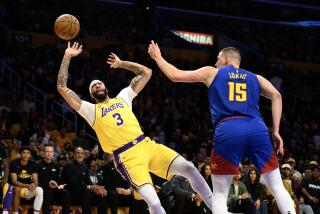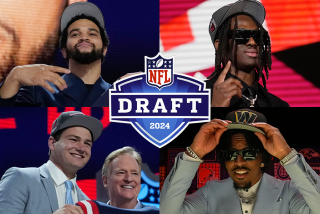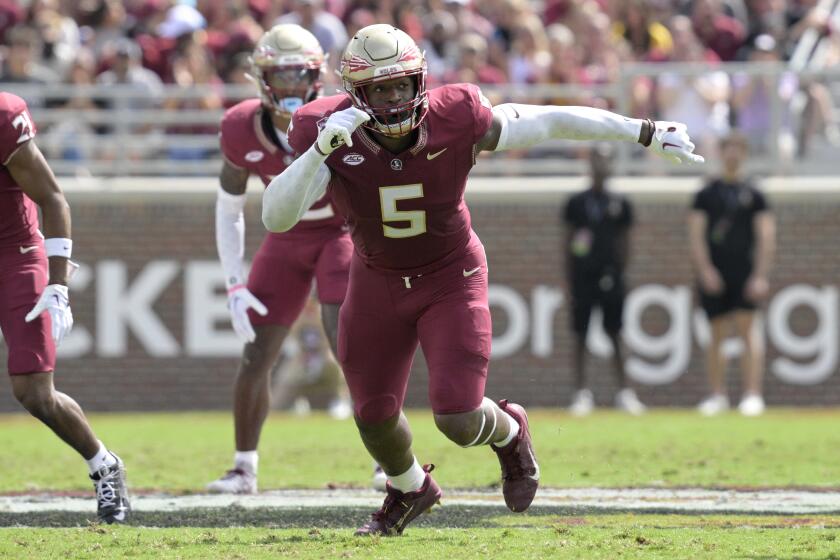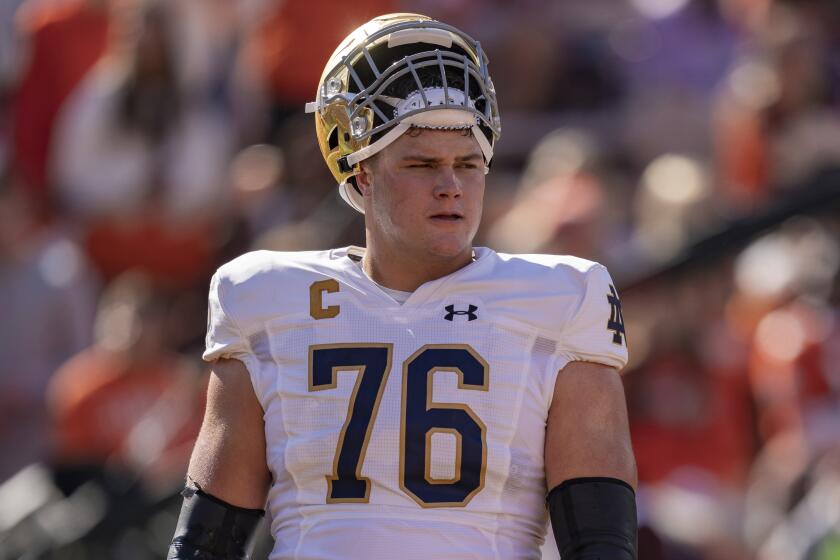Thriving Auto Club Speedway has history of peaks, valleys
At the tunnel entrance leading to the infield of Auto Club Speedway, there’s a blown-up photo printed on a wall that shows racing mogul Roger Penske cutting a checkered-flag ribbon to open the track that was then called California Speedway.
That was in 1997 and, as the speedway in Fontana celebrates its 20th anniversary with the Auto Club 400 NASCAR race Sunday, Penske remains proud of the 568-acre track he built on the site of a former steel mill despite the highs and lows the speedway has endured in the last two decades.
“We didn’t know what the reaction would be in such a major metropolitan market to what we were doing,” Penske said. “It’s become one of the best stops on the NASCAR schedule each and every year.”
True enough. Drivers in stock-car racing’s premier Monster Energy NASCAR Cup Series now love racing at the sweeping two-mile oval 50 miles east of Los Angeles, and the racing in recent years has seen several hair-raising finishes that kept spectators on their feet for the final laps.
But it wasn’t always so. Auto Club Speedway in many ways has mirrored the rise and fall of NASCAR’s overall popularity in the last 20 years.
The track’s construction was part of NASCAR’s nationwide expansion as interest in the sport grew in the 1990s. In the seven years after Jeff Gordon won the inaugural Cup race at Fontana in 1997, the track’s appeal dovetailed the surge in NASCAR’s popularity, and starting in 2004, NASCAR awarded Auto Club Speedway two Cup races a year.
“This was a very important track because of the expansion that was going on and how NASCAR was really taking off,” said Gordon, now a NASCAR analyst on Fox Sports.
Auto Club Speedway, which opened with 72,000 grandstand seats, also expanded to 92,000 seats to accommodate the growing interest, just as other tracks nationwide added seats as well.
But by 2007 it became clear that NASCAR’s popularity was starting to level off. Auto Club Speedway repeatedly was unable to sell out its two Cup races each year, leading naysayers to contend that Southern Californians — despite the region’s legendary car culture — simply were less interested in stock-car racing compared with fans in other parts of the nation.
Even NASCAR’s staunchest supporters agreed that the sport always has faced a tough sell in attracting Southern California fans because they have a long list of other entertainment choices.
The track’s former president, Gillian Zucker, often marketed the race with a Hollywood-centric feel to entice crowds, but popular NASCAR driver Dale Earnhardt Jr. said in 2007 that “people in Hollywood could care less.”
The track and NASCAR also were often derided for holding the races when Southern California temperatures were blistering hot, and for boring parade-like racing that denied fans the frequent passing they enjoy.
“There was a period of time where we would have long green-flag runs and the cars would really get spread out,” Gordon recalled.
Then came severe economic recession starting in 2008 sparked by a housing collapse that hit Inland Empire cities around Fontana especially hard.
Photos of swaths of empty seats at Auto Club Speedway became symbols of how the track appeared to be a dreary, wayward state in NASCAR Nation. But California was a leading indicator; soon the plunge in attendance for NASCAR racing spread nationwide.
It’s not easy to fill these grandstands. We try really hard to keep the ticket price at a point that’s reasonable.
— Dave Allen, Auto Club Speedway president
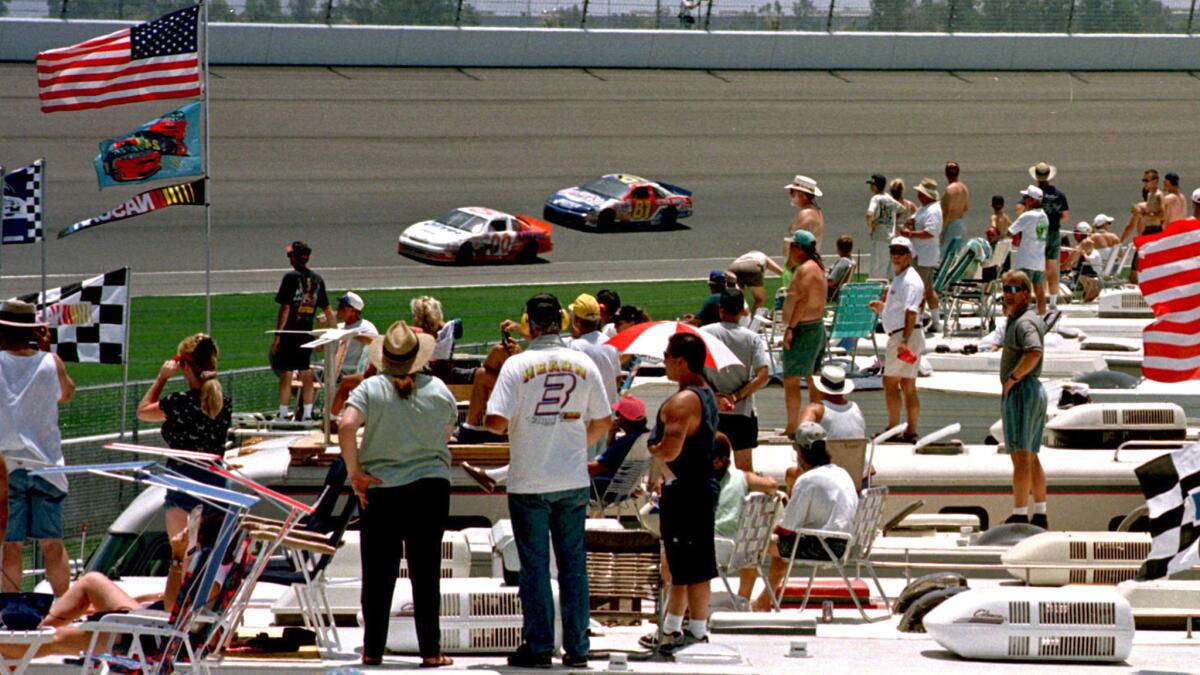
By mid-2010, NASCAR had seen enough. The sanctioning body moved one of Fontana’s two Cup races to Kansas starting in the 2011 season, leaving Auto Club Speedway with its sole Cup race in March.
Then the Fontana track and speedways across the country began slashing their seating capacity. Auto Club Speedway took out 26% of its seats, to the 68,000 seats its has today, and the races have been at or near sellouts since then.
One reason: As the Fontana track’s asphalt surface has aged, it’s better enabled drivers to race high, low and in between, which spawns three- and four-wide racing at 200 mph and contributes to the exciting finishes.
The result: Fontana has gone from being a poster child for NASCAR’s pullback to one of the favorite tracks among drivers and fans.
When Jimmie Johnson thinks of Auto Club Speedway, “I smile, I love it,” said the seven-time Cup champion who holds the record for most Cup wins, six, at Fontana, including last year’s race.
“We’re running from under the apron to the wall and it takes a track 10, 15 years to give us that opportunity,” Johnson said. “We’re finally there with this track and that’s what so exciting about it.”
Auto Club Speedway President Dave Allen agreed that “we’re in a really good space now” in large part because “the on-track racing product is better than it’s ever been. It all starts with that.”
Penske decided to build Auto Club Speedway after the demise of two other Southern California tracks: Riverside International Raceway, a venerable curvy road course, and Ontario Motor Speedway, which was similar to the famed Indianapolis Motor Speedway.
Penske, who runs NASCAR and IndyCar teams and oversees an automotive empire that includes car dealerships and truck rentals, built the Fontana track for $120 million on the site of a former Kaiser Steel plant.
He later sold the speedway to its current owner, International Speedway Corp., a track operator controlled by the France family that runs NASCAR.
Auto Club Speedway also hosted IndyCar series races for many years, most recently in 2015. But IndyCar’s popularity has fallen off sharply in the last 20 years and the races in recent years suffered from a lack of “date equity,” or fans being able to count on the race being held at about the same date each year.
The 2015 IndyCar race at Fontana, held in June, drew a paltry crowd of roughly 10,000 and IndyCar did not return to Fontana last year.
As for NASCAR, Penske said, “it’s huge for the the sport to be seen in the L.A .market.” But Allen said that regardless of how NASCAR’s popularity rises and falls, selling seats in Southern California always has been challenging.
“It’s not easy to fill these grandstands,” Allen said. “We try really hard to keep the ticket price at a point that’s reasonable,” with grandstand seats starting at $45 for Sunday’s Auto Club 400, he said.
The aging track that Penske first built, and its contribution to exciting racing, is perhaps the top asset that helps keep fans coming to Fontana, Allen said.
Would Fontana have to be repaved in the near future anyway because the surface is getting too old? “I hope not,” Allen said. “We’ll hold it together and go as long as we can.”
Twitter: @PeltzLATimes
More to Read
Get our high school sports newsletter
Prep Rally is devoted to the SoCal high school sports experience, bringing you scores, stories and a behind-the-scenes look at what makes prep sports so popular.
You may occasionally receive promotional content from the Los Angeles Times.
